Worldwork & Conflict Transformation Books
Books by Arnold Mindell
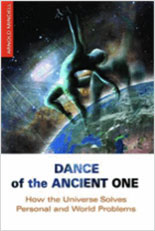 Dance of the Ancient One
Dance of the Ancient One
Arnold Mindell
2013
Dance Of The Ancient One is a new space-based movement meditation to facilitate personal and international issues. Dance of the Ancient One is an interdisciplinary method and experience connecting psychology, physics, and spirituality. This method can be used to work with difficult personal situations and organizational issues. The author shows in 24 chapters, with 60 pictures and at least 30 inner work exercises how to use this new “dance” for relationships and organizational group work. This book is filled with many different kinds of international personal and group stories.
Dr. Arnold Mindell, is originator of processwork or process oriented psychology. He is author of twenty books, has years of experiencein private practice, open forums, small and large group organizational and government facilitation.
The viewpoint of this book is simple: facilitators dealing with personal and world problems need this new “dance” for detachment, insight and empathy to deal effectively with apparently impossible inner and world issues. However “Dance of the Ancient One” is not just about conflict, anger or love, but stresses a “big picture”, a special feeling for the universe we live in. This feeling is related to Einstein’s space-time, that is the fabric of the universe. Mindell shows the experience of the universe’s space-time, or gravity may be a central element not only of many spiritual traditions, but also of future psychologies, psychiatry, and organizational management.
Arnold Mindell, (2013) Dance of the Ancient One, How the Universe Solves Personal and World Problems, Deep Democracy Exchange, Portland OR, USA
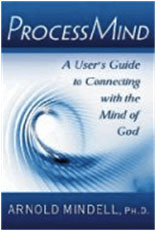 ProcessMind, A User’s Guide to Connecting With The Mind of God
ProcessMind, A User’s Guide to Connecting With The Mind of God
Arnold Mindell
2010
Einstein said, “I want to know the mind of God, the rest are details”. This book is therapist Arnold Mindell’s response. By processmind he means an earth-based experience of the universal state of consciousness that, he argues, pervades all reality. It is perhaps our most basic, least known, and greatest power, combining the nonlocality of modern physics with altered states of consciousness found in peak experiences.
What makes this book unique is that it offers some experience of this mind-state to the reader. Mindell does so by connecting cosmic patterns seen in physics with experiences occurring in psychology and world spiritual traditions. He draws together ideas about Aboriginal totem spirits, quantum entanglement, and nonlocality to describe the “structure of God experiences.” Enhancing his clear presentation are around 80 illustrations and 30 experiential exercises based on tested approaches that actualize our deepest, unitive consciousness. Through rational thinking and earth-based, inner experience, the reader can sense how the processmind’s self-organizing intelligence helps with dreams, body symptoms, relationships, and large-group conflict issues. Altogether, the book is a kind of user’s guide to tapping into an immense power that can benefit our own individual life and, ultimately, the world.
Arnold Mindell, (2010) ProcessMind, A User’s Guide to Connecting With The Mind of God, Theosophical Publishing House, Chennai India
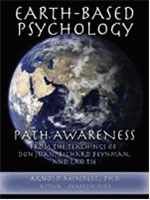 Earth-Based Psychology: Path Awareness from the Teachings of Don Juan, Richard Feynman, and Lao Tse
Earth-Based Psychology: Path Awareness from the Teachings of Don Juan, Richard Feynman, and Lao Tse
Arnold Mindell
2007
Drawing liberally from physics, psychology, aboriginal beliefs, and shamanism, this spiritual guide defines, explores, and applies both earth-based psychology and the related idea of path awareness—the innate ability to sense where to turn at a given moment.
By drawing together disparate elements of contemporary science and ancient wisdom, it is shown here that new methods emerge of determining the best direction through inner turmoil, relationship trouble, team and community issues, and world issues. Jung’s work is taken further and linked with diverse disciplines and wisdom traditions, making scientific ideas accessible to nontechnical readers. Theory and experiential exercises are presented in a simple, imaginative manner, with diagrams and illustrations to strengthen lessons for readers.
Mindell, A. (2007). Earth-Based Psychology: Path Awareness from the Teachings of Don Juan, Richard Feynman, and Lao Tse. Portland, OR: Lao Tse Press.
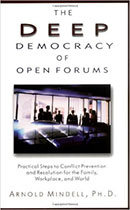 The Deep Democracy of Open Forums: Practical Steps to Conflict Prevention and Resolution for the Family, Workplace, and World
The Deep Democracy of Open Forums: Practical Steps to Conflict Prevention and Resolution for the Family, Workplace, and World
Arnold Mindell
2001
Most of us are terrified of conflict, says Arnold Mindell, PhD, author of fifteen books and internationally recognized for his innovative synthesis of Jungian therapy, dreams, and bodywork. But we needn’t be. His burning passion is to create groups and organizations where everyone looks forward to group processes instead of fearing them. He calls this the deep democracy of open forums, where all voices, thoughts, and feelings are aired freely, especially the ones nobody wants to hear.
Since 1992, one of Mindell’s prime interests has been the bringing of deeper awareness to group conflicts. Conflict work without reference to altered states of consciousness is like a flu shot for someone in a manic or depressed state of consciousness. Most group and social problems cannot be well facilitated or resolved without access to the dreamlike and mystical atmosphere in the background. The key is becoming aware of it.
Mindell introduces a new paradigm for working in groups, from 3 to 3,000, based on awareness of the flow of signals and events. You can take the subtlest of signals indicating the onset of emotions such as fear, anger, hopelessness, and other altered states, and use them to transform seemingly impossible problems into uplifting community experiences. As Mindell explains, “I share how everyone—people in schools and organizations, communities and governments—can use inner experiences, dreaming, and mysticism, in conjunction with real methods of conflict management, to produce lively, more sustainable, conscious communities.”
Mindell, A. (2002). The Deep Democracy of Open Forums. Charlottesville, VA: Hampton Roads.
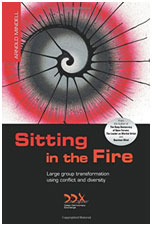 Sitting in the Fire
Sitting in the Fire
Arnold Mindell
1995
Using examples ranging from disputes in small organizations to large-scale conflicts in countries around the world, Sitting in the Fire offers practical methods for working with conflict, leadership crises, stagnation, abuse, terrorism, violence, and other social action issues. It brings an understanding of the psychology of conflict and the knowledge that many disputes can be traced back to inequalities of rank and power between parties, providing tools that will enable people to use conflict to build community.
Mindell, A. (1995). Sitting in the Fire: Large Group Transformation using Conflict and Diversity (1st ed.). Portland, Or.: Lao Tse Press.
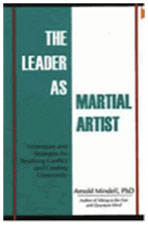 The Leader as Martial Artist
The Leader as Martial Artist
Arnold Mindell
1992
A groundbreaking examination of conflict resolution and leadership. The Leader as Martial Artist shows how confronting the challenges of today’s world requires the skill of a martial artist: a leader who exhibits flexibility, balance, detachment, intensity, sure instinct, and keen awareness in the midst of group chaos and confusion. For readers interested in conflict resolution and organizational dynamics, Leader as Martial Artist is a great place to start.
Mindell, A. (1992). The Leader as Martial Artist: An Introduction to Deep Democracy (1st ed.). San Francisco: Harper San Francisco.
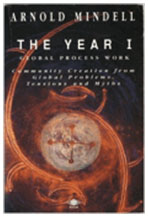 The Year I. Global Process Work. Community Creation From Global Problems, Tensions And Myths
The Year I. Global Process Work. Community Creation From Global Problems, Tensions And Myths
Arnold Mindell
1990
A first book about the mythic background to world problems, and descriptions of new methods for dealing with large groups.
Mindell, Arnold (1989). The Year I: Global Process Work with Planetary Myths and Structures. New York and London: Viking-Penguin-Arkana.
Books by Other Practitioners of Processwork
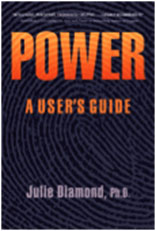 Power A User’s Guide
Power A User’s Guide
Julie Diamond
2016
The path toward ethical, authentic, and effective use of power is illuminated in this comprehensive crash course in developing external authority, navigating high-power roles and responsibilities, and finding personal power. The book combines cutting-edge psychological theory with practical exercises, stories, and examples from the author’s experiences as a leadership coach and consultant to provide readers with the tools and instructions to find their unique map of powers. From bosses to parents, politicians to protesters, power rests in the hands of everyone, everywhere.
Julie Diamond PhD, (2016), Power A User’s Guide, Belly Song Press
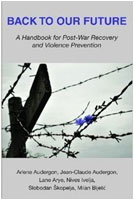 Back to Our Future: A Handbook for Post-War Recovery and Violence Prevention
Back to Our Future: A Handbook for Post-War Recovery and Violence Prevention
Audergon Arlene, Audergon Jean-Claude, Arye Lane, Ivelja, N., Skopelja, S. Bijelic
2010
It’s a far-reaching idea, when people from different sectors of society and from different sides of a conflict can gather together to grapple with the aftermath of violence and how to build the future together – discovering how conflict is perpetuated, recognising how we each take part, and how we each make a difference. We hope this handbook contributes to the profound need for effective models to interrupt cycles of violence, and to recognise the extraordinary resources within people, and the hope and practical capacity within post-conflict regions to build thriving societies. This handbook reflects a sea-change that is necessary and underway. Building an emotional and relational infrastructure is key to all aspects of post-conflict recovery, economic and community development, as well as preventing future violence.
Audergon, A., Audergon, JC., Arye, L., Ivelja, N., Skopelja, S. Bijelic, M.Back to Our Future: A Handbook for Post-War Recovery and Violence Prevention, (2010)
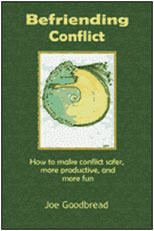 Befriending Conflict
Befriending Conflict
Joseph Goodbread
2010
Befriending conflict – what an idea! Among the hundreds of people author Joe Goodbread has helped with conflicts ranging from everyday family and neighborly disputes, to the Troubles in Northern Ireland, most would rather avoid conflict completely, than risk the emotional pain, potential violence, and loss of personal power that they associate with conflict. But each year, more and more people are finding that conflict can be fun! Using the simple methods of Befriending Conflict, you, too, can enjoy the buzz of productive and humane conflict, deepening your most important relationships while minimizing the risk of escalation and loss.
Befriending Conflict is a concise, “how to” book that gives you easy steps for recycling conflict into personal growth, sustainable relationships, and self-empowerment. Befriending Conflict fills a growing need for guidance in dealing with emotions and other disturbing states of mind in all aspects of conflict facilitation and dispute resolution, a topic that is gaining increasing attention as the more technical aspects of conflict management mature. Befriending Conflict is the first book that shows how strong emotions and power, approached with curiosity and awareness, can enhance any conflict management method, in any venue. In addition to standing on its own as a guide to preparing for conflict, it can be used as an adjunct to any other work on conflict management. Befriending Conflict rests on age-old principles brought up to date and presented in the form of simple exercises, accessible to anyone with an interest in making conflict into more of an ally and less of a feared but unavoidable burden.
Goodbread, J., Ph.D. (2010). Befriending Conflict: How to make conflict safer, more productive, and more fun. Scotts Valley, CA: CreateSpace
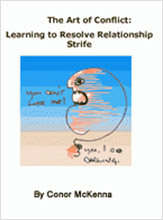 The Art of Conflict: Learning to Resolve Relationship Strife
The Art of Conflict: Learning to Resolve Relationship Strife
Conor McKenna
2010
Going through the steps in this course you will find examples, specific tools and exercises to help you practice and interact with your own awareness regarding conflictual situations in your life, either in the past, the present or with possible future problems.
In this course you will learn:
- How to enter a conflict and exit it without being “taken” by it
- How to use roles and ghost roles and how they structure and create conflict in the background
- Discover that there are only 3 sides to any conflict, that have access to them within you, and that with such knowledge you can resolve any conflictual situation
- How 3rd parties are used against you unconsciously to disarm you and how to reverse that
- How to enter altered states of consciousness to your own, and your partner’s benefit
- Know and enter consciously the inherent structure of the polarities in conflicts and change the dynamics to your benefit
- Use “crazy wisdom” that is often hidden in tension, to resolve difficult situations and learn how to have fun with conflict
- The role of body signals in quarreling and fighting
- Learn about feedback and how to work with it skillfully
- Discover dream figures when polarised and how they influence our actions in the background
- Investigate the “high” and “low” dream of your relationships and how such knowledge transforms strife
- Develop a metacommunicator and create choice and freedom without fear
- Solve conflicts and problems while your opponent is not there; to the benefit of your opponent and yourself
- Solve the problem for both of you in front of your opponent with inside knowledge
- Discover your inner, as well as your outer opponent and how to get the inner opponent on your side; inner opponents can be more difficult to befriend but will create flexible and unshakable confidence and render the outer situation more neutral
- Determine the “we” and the “non-we” of your relationship or friendship to create new life and energy
- How to drop conflict and how to start it
- How to value conflict, complete it, and deepen relationship
- Discover the role of Rank and Privilege in creating and resolving problems
And much more.
McKenna, C. (2010). The Art of Conflict: Learning to Resolve Relationship Strife. Duns, Scottish Borders: ProcessWorkFocus.
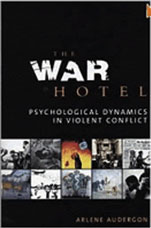 The War Hotel: Psychological Dynamics in Violent Conflict
The War Hotel: Psychological Dynamics in Violent Conflict
Arlene Audergon
2005
Human Nature is the fuel of violent conflict. The War Hotel looks at how we get aroused and how we get silenced into violent conflict. We are pulled apart in the name of justice and loyalty. Past trauma is triggered into a replay. Out of love and longing to step beyond the ordinary world, we sacrifice ourselves and others. Dehumanizing the enemy, disinformation, torture, stirring fear in order to crack down – these terror tactics, too, are based in psychology. The manipulation of psychological dynamics to create violent conflict is distressing. But, if our emotions and behaviour are the fuel, then our awareness can impact world events. There is something truly hopeful here. Awareness makes a difference. (Examples draw particularly from the author’s work in the Balkans. Other examples include Nazi Germany, Rwanda, the Israeli–Palestinian conflict, Communism and its fall in Europe, South Africa, the treatment of Native Americans and African Americans in the USA, Vietnam and the ‘war on terror’.) In War Hotel, Arlene introduces a Chart of Symptoms of PTSD in Individuals and Signs of Communal and Collective Trauma, formally presenting the connection between PTSD symptoms in individuals, group, communities, and traumatized societies.
The War Hotel is an ambitious, fascinating exploration of the psychology of conflict, from American street gangs to bloodshed in the Balkans. With Arlene Audergon as guide, the reader takes an enlightening journey to the hidden underside of modern war, and finds a ray of hope that humankind can, indeed, ‘break free from the nightmare’. -Charles J. Hanley, Pulitzer Prize-winning Associated Press special correspondent, with 30 years of experience covering war zones and co-author of The Bridge at No Gun Ri; A Hidden Nightmare from the Korean War.
From her rich personal experience working in conflict areas, Arlene Audergon not only describes the inner and outer nature of war, but the personal and community developments we must make to find relief, resolution and a wise center in the midst of it all. – Arnold Mindell, international conflict facilitator, author of The Deep Democracy of Open Forums and Sitting in the Fire.
Audergon, A., Ph.D. (2005). The War Hotel: Psychological Dynamics in Violent Conflict. London: Whurr.
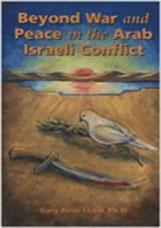 Beyond War and Peace in the Arab Israeli Conflict
Beyond War and Peace in the Arab Israeli Conflict
Gary Reiss
2004
In Beyond War and Peace in the Arab Israeli Conflict, author Gary Reiss draws on his experience in the Middle East to help those of us living in conflict move toward resolution. Using the tools of process-oriented psychology,the author illustrates how we can move beyond the domination and revenge of war and the temporary harmony of treaties into more lasting, and satisfying, resolutions. Using examples of his work in Israel and the Occupied Territories, Reiss shows us how people can learn to interact with each other on the personal, political and spiritual level to reach moments of oneness and peace. Practical exercises will help anyone living in conflict, be it personal or political, reach greater insight and resolution.
Reiss, Gary 2004. Beyond War and Peace in the Arab Israeli Conflict. Eugene, OR: Changing Worlds Press.
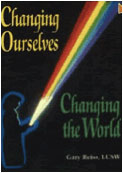 Changing Ourselves, Changing the World
Changing Ourselves, Changing the World
Gary Reiss
2000
Most people feel disturbed by the political and social problems we see every day yet, at the same time, feel helpless to solve them. We feel even more disturbed as we and others give up our personal power in futile attempts to solve these problems. We have given our power away to politicians and others who accomplish little or nothing as they serve their own narrow interests. People have become apathetic because the world situation is just too overwhelming. This book will help you to view the world situation in a way that is not overwhelming. It provides ways for you to take back your power for personal growth and social change.
Reiss, G. (2000). Changing Ourselves, Changing the World.
Worldwork & Social Issues Books
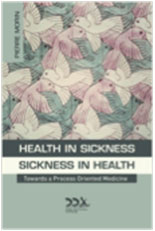 Health in Sickness, Sickness in Health
Health in Sickness, Sickness in Health
Pierre Morin
2014
This book is about valuing health and sickness. It is about seeing sickness-in-health and health-in sickness. It is about discovering our diversity, which includes processes that go beyond the narrow margins of conventional health and normality. It’s about putting an end to current conceptions of health and normality and espousing a new medical process- and community-based paradigm.
Pierre Morin (2014), Health in Sickness – Sickness in Health,
Deep Democracy Exchange Portland, Oregon USA
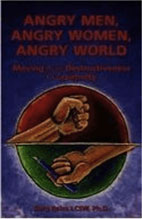 Angry Men, Angry Women, Angry World. Moving From Destructiveness to Creativity
Angry Men, Angry Women, Angry World. Moving From Destructiveness to Creativity
Gary Reiss
2014
In Angry Men, Angry Women, Angry World—Moving From Destructiveness to Creativity, psychotherapist Gary Reiss shows us how to transform destructiveness into creativity that can heal our bodies, relationships and the world. In a world where family violence, suicide, and violence between nations all burn like wildfires, the author’s practical examples, exercises and theory will excite and inspire readers to transform anger and violence into creative powers. Using examples from his own life, his therapy practice, and his conflict work in the Middle East, Gary Reiss shows the reader how to harness the power of rage for healing.
Reiss, Gary. 2004. Angry Men, Angry Women, Angry World. Eugene, OR: Changing Worlds Press.
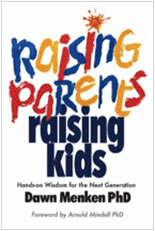 Raising Parents, Raising Kids: Hands-on Wisdom for the Next Generation
Raising Parents, Raising Kids: Hands-on Wisdom for the Next Generation
Dawn Menken
2013
In this cutting-edge book, therapist, parent, and visionary Dr. Dawn Menken introduces a fresh approach to the joy and wonder of the world of parenting. Going beyond the conventional “how to” book, this is the ultimate guide to nurturing the emotional, spiritual, and social lives of children, helping parents create a more meaningful relationship with their children by supporting their deepest nature. Loaded with practical tips, inspiring examples, and her own intimate stories, Menken uses the principles of process-oriented psychology to help parents, caretakers, and educators navigate the complex waters of conflict, power dynamics, diversity, and other social challenges, offering groundbreaking insights and techniques to tackle the burgeoning problem of bullying. Menken goes on to address typical challenges of the parenting relationship, parents’ own personal growth, and the call to parent not only our children, but also the planet, and ultimately ourselves.
Dawn Menken PhD (2013), Raising Parents, Raising Kids: Hands-on Wisdom for the Next Generation, Belly Song Press
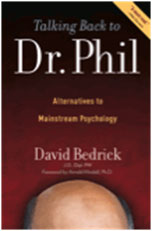 Talking Back to Dr. Phill
Talking Back to Dr. Phill
David Bedrick
2013
Utilizing in-depth research and analysis, this volume debunks the quick fixes and simplistic explanations of Dr. Phil McGraw. While he’s watched and revered by millions, no critique exists for his daytime advice—and like much of “pop psychology,” his counsel is often ineffective, leaving people feeling like failures and that something is wrong with them. Readers will easily identify with the guests and stories from actual Dr. Phil episodes, on topics ranging from anger, sex, addictions, and dieting to domestic violence, race, and gender. A powerful, love-based alternative psychology is then offered, basing itself on the belief that there is profound meaning in people’s struggles. Story after story shows how people’s difficulties are seeds of their unique beauty, power, and intelligence, elevating rather than diminishing their esteem. The insight and compassion for people’s humanity provided here cuts through the easy sound bites and will leave people feeling a genuine love for who they really are.
David Bedrick, (2013) Talking Back to Dr. Phill, Belly Song Press
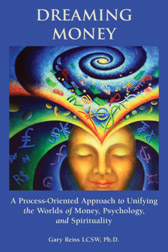 Dreaming Money: A Process-Oriented Approach to Unifying the Worlds of Money, Psychology, and Spirituality
Dreaming Money: A Process-Oriented Approach to Unifying the Worlds of Money, Psychology, and Spirituality
Gary Reiss
2013
Dreaming Money, by Dr. Gary Reiss, shows us how we can live a life where money, passion, and meaning flow, and where we can manifest abundance and happiness, while taking care of the world. Dreaming Money brings back ancient mystical wisdom, and combines this with powerful psychological techniques to reveal the secrets as to how your dreams and dreamlike experiences can guide you down an easier, more direct path to wealth, and how to utilize this wealth to create more meaning in your life. With today’s current economic crisis that has generated so much suffering and fear, these methods become even more relevant and useful for the average person. Our livelihood needs to be a central part of our spiritual path. Dreaming Money is based on the principles of Process-oriented Psychology, founded by Dr. Arnold Mindell. Process-oriented Psychology provides us with powerful tools that help us address material concerns on all levels—physical, emotional, and spiritual.
In Dreaming Money, Dr. Reiss brings together the realities of money, dreams and spirituality. Reiss shows not only how money is connected to the deepest life path, but also how earning money is based not just on being but also being. What a timely, hopeful book to help people step into their financial dreaming! – Dr. Arnold Mindell, founder Process Oriented Psychology
Reiss, G (2013). Dreaming Money: A Process-Oriented Approach to Unifying the Worlds of Money, Psychology, and Spirituality. Eugene, OR: Changing Worlds Publications
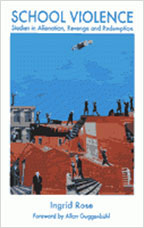 School Violence
School Violence
Ingrid Rose
2009
Experiences of violence in school are encountered much more frequently than they used to be. The shocking repercussions of these acts are felt nationwide and particularly impact school populations, families, and communities. This book undertakes to illuminate factors pertaining to the phenomenon of school violence. What makes this book particularly interesting is its depth-oriented view into behavioural and systemic dynamics, arely explored before in this context.
In exploring the inner worlds of disturbed students, the aim of this book is twofold. One important aspect is to bring enhanced understanding of dynamics involved in incidents of school violence to professionals, family members, school staff, and the larger social system. The other facet ot this book focuses on the initroduction of tools and techniques that can be used to bring ou the inner experiences of students that usually remain unspoken and unaddressed. In utilizing dream figures, myth, image, body awareness, and group dialogue, previously ignored or repressed phenomena can find a place in which they can be contained and acknowledged.
School Violence is a vital, timately contribution. Dr Rose recognizes that chronic denial of the daimonic is at least as dangerous in adolescence as adulthood. She skillfully applies the penetrating insights of depth psychology to decipher the deepening epidemic of anger, rage, and violence in our schools. This book courageously honors the therapeutic power, wisdom, and value in acknowledging and constructively expressing the daimonic or shadow orather than destructively repressing and demonizing it. –Dr Stephen Diamond, author of Anger, Madness, and the Daimonic
In this helpful new book on school violence, Dr Ingrid Rose brings us theories and new practical methods for understanding and dealing with alienation, revenge, and the place of student conflicts in the larger educational and social systems. –Dr Arnold Mindell, author of Sitting in the Fire
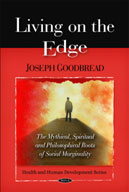 Living on the Edge: The Mythical, Spiritual, and Philosophical Roots of Social Marginality
Living on the Edge: The Mythical, Spiritual, and Philosophical Roots of Social Marginality
Joseph Goodbread
2009
This book starts by seeking to answer the question, ‘Why do the people who fight our wars and clean up our natural and self-made disasters wind up on the margins of society?’ Based on the author’s work with a group of Chernobyl liquidators – members of the army of more than 750,000 who decontaminated and sealed the site of the 1986 nuclear reactor disaster – the book explores the processes that lead those who start off as heroes to be ultimately despised and rejected by the very society they rescued.
A key to this mystery is found in the ancient Chinese creation myth of Pan Ku, in which the universe is created from the fragmentation of the body of an immense primal being, while human beings are created from the vermin on its body- the very essence of a marginal existence. The journey leads us through an exploration of experiential philosophy, mythology, linguistics, and psychology to the very roots of reality itself.
“Living on the Edge” then applies this model of social marginalisation to understanding the why and how the mentally ill are marginalised, shedding light on why, once we are at the margins, return to mainstream society is so difficult. The book concludes with some suggestions about how to make marginalisation more of a process and less of a fixed state through the arts and mass media.
Goodbread, J., Ph.D. (2009). Living on the Edge: The Mythical, Spiritual, and Philosophical Roots of Social Marginality New York: Nova Science Publishers.
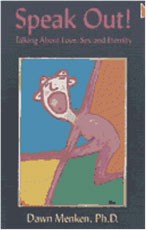 Speak Out! Talking About Love, Sex & Eternity
Speak Out! Talking About Love, Sex & Eternity
Dawn Menken
2002
With humor, grace, and keen vision, Speak Out! shows how the diverse members of our modern world can learn to appreciate one another by following the mysterious spirit of life. Dr. Menken demonstrates how we can move beyond simple tolerance into a joyous celebration of the unique beauty of all perspectives. Speak Out! explores the relationship between the mainstream and marginalized groups, the nature of love, the spirit of relationship, and the making of true community. Sometimes irreverent, often poignant, always insightful.
Her insightful awareness into the important issues of today make this book a must for all readers. — Amy Mindell, Ph.D., author of Metaskills
Takes the art of consciousness-raising to a new level: our most intimate personal experiences can be doorways to eternity. — Sara Halprin, Ph.D., author of Look at My Ugly Face!
With skill and compassion she deals with the difficult subject of marginalization and the conflicts it engenders. — Dr. Joseph Goodbread, author of Radical Intercourse
Menken, D. (2002). Speak Out! Talking About Love, Sex & Eternity. Tempe, AZ: New Falcon Publications.
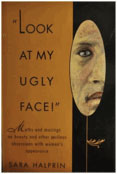 Look at My Ugly Face: Myths and Musings on Beauty
Look at My Ugly Face: Myths and Musings on Beauty
Halprin, Sara
1995
An exploration of the relationship among appearance, identity, and power shows how myths of beauty can be liberating rather than confining, developing insights that can connect women to the archetype of the all-powerful triple Goddess.
Halprin, Sara. 1995. Look at my Ugly Face. Myths and Musings on Beauty and Other Perilous Obsessions with Women’s Appearance. New York: Penguin.
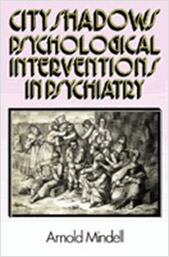 City Shadows
City Shadows
Arnold Mindell
1988
The city shadows are the repressed and unrealized aspects of us all, lived openly by the so called and psychiatrically diagnosed “mentally ill.”
In City Shadows Arnold Mindell presents new challenges and theories to mental health professionals and the public.
Mindell, A. (1988). City shadows: psychological interventions in psychiatry. New York: Routledge.
Worldwork Seminar Books
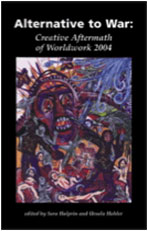 Alternative to War: Creative Aftermath of Worldwork 2004
Alternative to War: Creative Aftermath of Worldwork 2004
Halprin, Sara and Ursula Hohler
2004
Sara Halprin and Ursula Hohler’s collection brings together the creative work of some of those who attended Worldwork 2004 on the Oregon coast. The range of contributions reflects the extraordinary scope of world work and of process work itself. The pieces move from strong prose descriptions of unearthing and expressing the feelings, the histories, and ultimately the raw energy at the root of war, through to gentle poetry expressing connection and liberation. They give voice in a graphic and personal way to the experience of unfolding the unknown and the discovery of new and creative directions which might indeed provide an “Alternative to War”.
Halprin, Sara and Ursula Hohler, eds. 2004. Alternative to War: Creative Aftermath of Worldwork 2004. Eugene, OR: Changing Worlds Publications.
Books on Other Areas of Processwork Theory
Books by Amy & Arnold Mindell
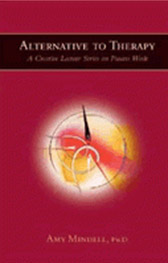 Alternative to Therapy: A Creative Lecture Series on Process Work
Alternative to Therapy: A Creative Lecture Series on Process Work
Amy Mindell
2005
The innovative concepts and practical methods of Process-Oriented Psychology (process work)—many of which have never been published—are explored in this highly unusual textbook. The goals of process work lay not in traditional psychotherapeutic theory, but rather in the unique wisdom and path of process, or nature, itself. Each of the 32 chapters represents a “class” in which one of the principles is highlighted and investigated from many angles, allowing the author to present the highly structured content in a playful way that is both attractive and useful to helpers and therapists from many different backgrounds.
Mindell, A. (2006). Alternative to Therapy: A Creative Lecture Series on Process Work. Portland, OR: Lao Tse Press.
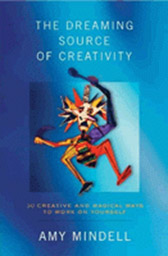 The Dreaming Source of Creativity: 30 Creative and Magical Ways to Work on Yourself
The Dreaming Source of Creativity: 30 Creative and Magical Ways to Work on Yourself
Amy Mindell
2005
Written for professional therapists as well as the interested layperson, this book reveals where hidden sources of creativity and inspiration can be found in everyday life, such as in the body, the environment, material objects, or even daily activities. Numerous stories, exercises, and pictures illustrate this take on creativity from a process work perspective by tapping into art, music, puppets, movement, and more. This inspirational guide to bringing artistic elements into one’s life examines dreams, body experiences, and overall life situations.
Mindell, A. (2005). The Dreaming Source of Creativity: 30 Creative and Magical Ways to Work on Yourself. Portland, OR: Lao Tse Press.
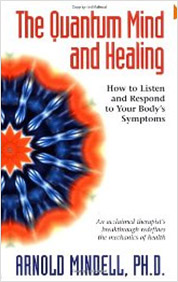 The Quantum Mind and Healing: How to Listen and Respond to Your Body’s Symptoms
The Quantum Mind and Healing: How to Listen and Respond to Your Body’s Symptoms
Arnold Mindell
2004
Dr. Arnold Mindell’s latest work goes further than his previous Quantum Mind and lays the ground for 21st century healing. Anyone practicing medicine or needing healing today will find great value in reading it. Mindell, taking up where Carl Jung left off, has emerged as the leading expert in the uses of metaphors and concepts from quantum physics to heal the mind and psyche. This book is both an opportunity to learn psychology and how quantum physics notions offer new hope as well as a manual of operations for the psyche filled with new processes and imaginative insights. —Fred Alan Wolf, PhD, Author of Cheating Time, Matter into Feeling, Mind into Matter, and Taking the Quantum Leap,
There is a force underlying all action and circumstance in the universe and you have the ability to tap into this force, interact with it, and use it to heal yourself.
This is science talking. Specifically, this is Dr. Arnold Mindell?’s new model of medicine based on the mind-blowing findings of a host of quantum physicists?—pioneers who are reconfiguring the landscape of our world and belief structure on an almost daily basis.
Dr. Mindell is an internationally recognized psychotherapist whose ahead-of-the-curve work led him to found a new school of therapy called Process Oriented Psychology. A graduate of MIT and the Jungian Institute of Zurich, Dr. Mindell is an in-demand speaker at conferences worldwide as well as the author of sixteen previous books.
Despite his many achievements, it is not a stretch to say that The Quantum Mind and Healing is quite probably MindellÂ’s most important and best work yet. In it, Mindell explains that you can use the discoveries of quantum physics to access your bodyÂ’s own intelligence and self-healing abilities. Embracing both conventional and alternative medicine, he shows that to truly heal you need both medicine and your own natural wisdom.
The Quantum Mind and Healing goes well beyond theory, giving you simple techniques, guided exercises, and precise explanations of vital concepts that will enable you to uncover, understand, and eliminate the root causes of even your chronic symptoms and illnesses. With applications beyond physical healing, The Quantum Mind and Healing can also help you overcome long-term emotional and behavioral patterns that may be keeping you from living your greatest potential.
Mindell, A. (2004). The Quantum Mind and Healing: How to Listen and Respond to Your Body’s Symptoms. Charlottesville, VA: Hampton Roads Publishing Company, Inc.
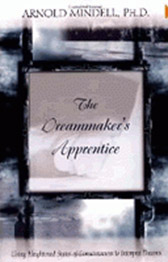 The Dreammaker’s Apprentice: Using Heightened States of Consciousness to Interpret Dreams
The Dreammaker’s Apprentice: Using Heightened States of Consciousness to Interpret Dreams
Arnold Mindell
2001
Psychotherapist Arnold Mindell goes deeper than ever before in his exploration of dreamwork as a tool for heightened perceptions and self-improvement. He draws on his 36 years of practice to create an exciting fusion of physics and psychology that puts you in the driver’s seat of your dreams and shows you what they mean. Dreams can be understood by watching carefully how we use our attention, how we move, and what we experience in our body and in altered states of consciousness.
Nighttime dreams are merely a reflection of the continuous flow of subtle signals, or flirts, that enter our awareness 24 hours a day. To interpret these daytime flirts and nocturnal signals, you must become the Dreammaker’s Apprenctice. Mindell shows how through an engaging series of exercies, stories, breathwork, and metaphors.
Mindell, A. (2001). The Dreammaker’s Apprentice: Using Heightened States of Consciousness to Interpret Dreams. Charlottesville, VA: Hampton Roads Publishing.
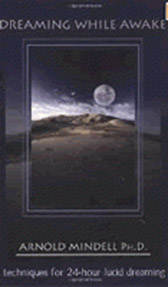 Dreaming While Awake: Techniques for 24 Hour Lucid Dreaming
Dreaming While Awake: Techniques for 24 Hour Lucid Dreaming
Arnold Mindell
2000
What if you could dream 24 hours a day, even while awake? According to innovative psychotherapist Arnold Mindell, Ph.D., we already do.
The seeds of dreaming arise in every moment of the day, in body symptoms, problems, relationships, subtile feelings, interactions, random thoughts, and fantasies. We’re getting countless little cues from the unconscious every minute. All are signs from the world of dreaming. And, according to Mindell, we can be in this state of lucid dreaming all day long. In Dreaming While Awake, Mindell shows how to become aware of these “flirts” from the dreamworld and how to interpret their message.
The goal, he says, is to be wide awake and lucid 24 hours a day in the midst of this unending dreamfield of information. Practicing 24-hour lucid dreaming: Helps you solve personal, physical, and emotional problems Serves as a preventive medicine for relationships and health, helping you catch the earliest warning signs before they turn into problems Helps resolve conflicts in relationships, families, large groups, corporations, even politics Dreaming is the mystical source of reality, says Mindell. “My goal is to make the Dreaming roots of reality so accessible, so visceral, that your conscious mind will give you back your right to dream.”
Mindell, A. (2000). Dreaming While Awake: Techniques for 24-hour Lucid Dreaming. Charlottesville, Va. Hampton Roads: Enfield.
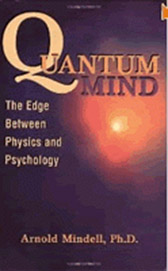 Quantum Mind: The Edge Between Physics and Psychology
Quantum Mind: The Edge Between Physics and Psychology
Arnold Mindell
2000
Quantum Mind: The Edge Between Physics and Psychology is the most comprehensive work to date venturing into that challenging junction of psychology, new physics, and shamanism. It takes the reader on a journey through the universe on paths of reason and magic, math and myth. By exploring principles found in psychology, math, physics, and shamanism, it becomes possible to link a cosmic perspective with ordinary life. Mindell assumes the reader has no prior knowledge of physics, and explores the fundamentals of math and physics in terms of psychological and Shamanic experiences.
Quantum Mind includes practical exercises based upon these principles to create a new understanding of the foundations of psychological health, relationships, and community. Mindell reveals how all of us can benefit by bringing together humanity’s traditional wisdom and shamanism with contemporary science.
Carl Jung predicted long ago that someday quantum physics and psychology will come together. This integration is the most fascinating aspect of the paradigm shift in science right now; however, until now only physicists have written about integrating psychology and physics, but psychologists have been quiet about it perhaps because physics still scares most psychologists. Finally, Arny Mindell, a famous psychologist, has come forward and what a treat his book Quantum Mind is. It is about many things you have wondered around this integration, and is so much more. Mindell makes it all exciting especially when he explores the subject of dreams which is his specialty. If you are curious about science’s most important paradigm shift, you will want to read this book and you will deepen your understanding. — Amit Goswami, Author of “The Self-Aware Universe: How Consciousness Creates the Material World” and “Quantum Creativity.”
Once again, Arny Mindell breaks new ground by bringing the world of quantum physics and psychology together. This is exciting and adventurous territory for anyone seeking wisdom. Quantum Mind provides a map to navigate this previously uncharted realm. Mindell, whose work has always been at the leading edge of psychology, demonstrates a mastery here that is a compelling read for all those willing to explore new possibilities. — Michael Toms, co-founder “New Dimensions Radio”
What Mindell accomplishes is breathtaking in its scope, and in its ability to communicate difficult ideas easily in a friendly teaching manner. Using his notes from the course taught for years to students of psychology, his experience as a therapist and physicist, and his clear writing ability makes this book a must-read for students and lay persons interested in the ever-growing field of depth psychology. Mindell sprinkles psychological exercises throughout the text providing the reader with imagined experiences of entering a black hole, appearing in parallel universes, taking the mind boggling quantum leap, and many, many others. It is at once a physics text, psychology text, and a friendly popular read. I highly recommend it. — Fred Alan Wolf, Ph.D., author of “The New Alchemy,” “The Spiritual Universe,” “The Dreaming Universe,” and the national book award winning “Taking the Quantum Leap.
Mindell, A. (2000). Quantum Mind: The Edge Between Physics and Psychology. Portland, OR: Lao Tse Press.
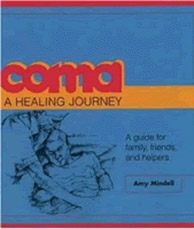 Coma: A Healing Journey
Coma: A Healing Journey
Amy Mindell
1999
In this step-by-step guide, Mindell shows family and helpers how to understand the subtle signal of the comatose person and set up a communication system that can facilitate expression of wishes regarding life and health-care.
In this immensely hopeful, helpful and readable book Mindell gives the reader factual information and reframes the term coma as an “altered state of consciousness” that can be worked with and learned from. — ForeWord Magazine Steven Holl February 1999
Mindell’s revolutionary guide paves the way for an exciting journey through the depths of human experience. It renders a diagnosis of coma anything but a dead-end road. — Linda J. Thorlakson Independent Publisher January 1999.
Amy Mindell, P. D. (1999). Coma: A Healing Journey. Portland: Lao Tse Press.
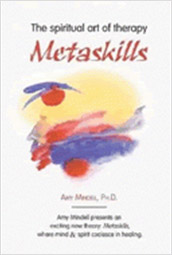 Metaskills: The Spiritual Art of Therapy
Metaskills: The Spiritual Art of Therapy
Amy Mindell
1995
Why is some therapy effective and some disappointing? Amy Mindell says it has to do with the subtle atmosphere created by therapists’ unconscious feelings and attitudes. By tapping into their deepest beliefs about spirit, nature, and human development (metaskills), they can become more effective healers and spiritual teachers.
Through years of researching Arnold Mindell’s work with individuals, couples, and groups, Amy Mindell has identified a number of feeling attitudes which she amplifies here through analogies to Eastern traditions, the teachings of Don Juan, and/or modern physics. She approaches the question of learning metaskills: Is it possible? How is it done? (She postulates that the therapist, not unlike the client, is on a path of spiritual development.) And she explains how the concept could revolutionize the vast field of psychotherapy. The book has numerous verbatim transcripts, as well as detailed theoretical and poetic explanations.
In addition to offering helping professionals an inspiring new approach to working with people, this book will also valuable to anyone interested in discovering the unconscious attitudes that can lead to a deeper self-knowledge and satisfaction in relationships.
Mindell, A. (1995). Metaskills: The Spiritual Art of Therapy. Tempe, AZ: New Falcon Publications.
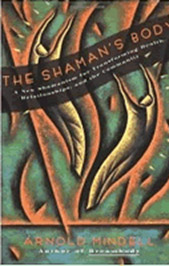 The Shaman’s Body
The Shaman’s Body
Arnold Mindell
1993
Arnold Mindell has encountered African, Native American, Australian aboriginal, and Indian Hindu healers firsthand and outlines the process of accessing one’s “dreambody” and developing a shamanic approach to everyday life, which is sometimes referred to as urban shamanism.
Each chapter wanders freely from modern psychotherapeutic understandings, enriched by Mindell’s experiences, to what he learned from traditional cultures. The book includes practical exercises to help the reader personally experience the teachings and better understand and access various forms of shamanism.
Mindell, A. (1993). The Shaman’s Body: a new shamanism for transforming health, relationships, and community (1st HarperCollins pbk. ed.). San Francisco, CA: HarperSanFrancisco.
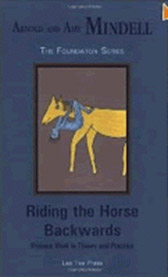 Riding the Horse Backwards
Riding the Horse Backwards
Amy & Arnold Mindell
1992
There was once a native American tribe with a crazy-wisdom trickster figure who was called “the reversed one” and did everything differently. His horse went forwards, for example, but he rode it facing backwards. That is how we ourselves might learn again how to enjoy living, argue the authors of this book – by turning our consciousness back to front so that we can start seeing and doing everything in a completely different way.
Riding the Horse Backwards is a wonderful case study, filled with presentations and analysis of personal work done by the Mindells working individuals during open seminars.
Mindell, A., & Mindell, A. (1992). Riding the horse backwards : process work in theory and practice. London, England: New York N.Y. USA.
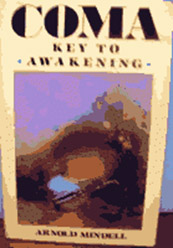 Coma: Key to Awakening
Coma: Key to Awakening
Arnold Mindell
1989
Arnold Mindell’s work with comatose patients offers a new direction in psychotherapy and in the study of near-death experiences. He argues that people in such states are not merely vegetables but human beings in an altered state of consciousness that may be an important experience for them: some report experiences of insight, ecstasy, and self-knowledge.
Offering verbatim bedside reports, theoretical discussion, and practical exercises; the author demonstrates his techniques for communicating with the comatose person based on process-oriented psychology.
In showing that the comatose person is able to communicate with others, the author argues that such patients can often make conscious, rational decisions; thus adding a new dimension to ethical and legal debates about near-death conditions.
Mindell, A. (1989). Coma: key to awakening (1st ed.). Boston Shambhala: [New York].
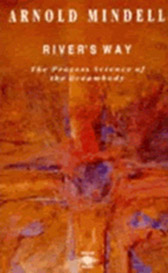 River’s Way
River’s Way
Arnold Mindell
1989
This book presents the reader with the theoretical framework behind Arnold Mindell’s two earlier studies of the psychology of body experience, Dreambody and Working With the Dreaming Body.
In bridging divisions between psychotherapy, medicine and physics, it provides both client and therapist with a flexible and integrative approach to the total personality.not simply an intellectual exercise and that successful therapy is the work of the “dreamer” as much as of the analyst. In the second part of the book the author shows how mythological symbols of energy and time (Oceanos, Aion and the Kundalini) form the roots of modern concepts of process.
The final chapter takes up and builds on Jung’s rediscovery of alchemy as the mother of modern medicine, psychology and physics. Mindell suggests that awareness itself might be the gold of the alchemists and that successful therapies are in part a discovery of the river’s way – the process of perception.
Mindell, A. (1989). River’s way: the Process Science of the Dreambody. London: Penguin Arkana.
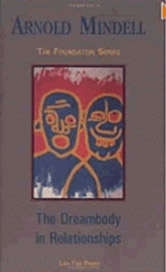 The Dreambody in Relationships
The Dreambody in Relationships
Arnold Mindell
1987
In The Dreambody in Relationships, Arnold Mindell extends his approach to the field of interpersonal relationships, including couples and family therapy.
Building upon his earlier works that explore the relationship between body experiences and dreaming, he shows how body signals, gestures, vocal tones, and unfinished sentences are the reflections of dreams and can be unfolded to reveal a deep current of meaningful connection in even the most difficult relationship processes.
The Dreambody in Relationships integrates family therapy with dream and bodywork, exploring the relationship between psychotherapy and information theory.
Mindell, A. (1987). The Dreambody in Relationships. London: New York.
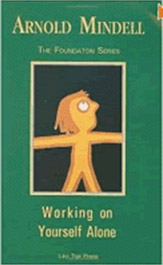 Working on Yourself Alone: Inner Dreambody Work
Working on Yourself Alone: Inner Dreambody Work
Arnold Mindell
1985
In this classic work, Arnold Mindell introduces us to a process-oriented meditation, a new body of philosophy and technique that unites the foundations of Western psychotherapy and Eastern meditative traditions in a single holistic system. You will re-discover your beginner’s mind that will guide you through body feelings, movement, auditory awareness, artwork, dreamwork, and yoga. Mindell’s techniques help access the full spectrum of your emotions and experience in the service of self-discovery.
Instead of suppressing negative emotions, process oriented meditation sees all experience as an opportunity to unfold the mysterious, dreamlike side of reality with its enormous potential for self-discovery and growth.
Mindell, A. (2002). Working on Yourself Alone: Inner Dreambody Work. Portland, OR: Lao Tse Press.
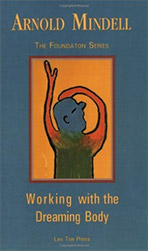 Working with the Dreaming Body
Working with the Dreaming Body
Arnold Mindell
1985
First published in 1985, Working with the Dreaming Body presents practical case studies, using the theory presented in Dreambody to connect dreams and body symptoms.
From the introduction:
Today, 85 years after Freud’s introductory discoveries, we are left with a very fragmented legacy called modern psychology. Body therapies are split off from dream therapies, and dream therapy is normally done without reference to body feelings. Relationship difficulties are either dealt with analytically, behaviorally, or as part of a system. People are treated like machines which can be programmed. Psychotic people are still locked up behind bars. The dying and diseased are chopped up by medicine men as if the flesh has no soul in it. It seems as if psychology is now composed ot bits and pieces, an unintegrated spectrum of many different colors which are poorly, if at all, connected to each other.
This book introduces a single theoretical framework which integrates the immense variety of human psychology. I call this framework of psychology “process work” because it is based upon discovering the exact more of channel in which the person is moving. My basic idea is to uncover this human process and follow it, whether it is diagnosed to be psychotic, terminal, gruop orientated, diseased, or normal.
Mindell, A. (2002). Working with the Dreaming Body. Portland: Lao Tse Press.
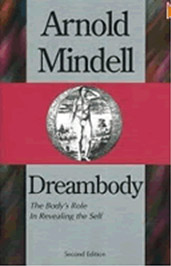 Dreambody
Dreambody
Arnold Mindell
1982
First printed in 1982, Dreambody was the first of Arny’s many books and introduced many radically new ideas. A classic in the field with many important contributions, those who are new to process oriented psychology might want to choose one of the later books to start with.
Headaches and tension as well as pain and illness are signposts from the unconscious with hidden information that can be used to transform our lives. Just as the unconscious talks to us through our bodies in physical symptoms.
In Dreambody, Arnold Mindell reveals the hidden significance of physical sensations and body experiences and shows how people’s bodies can lead them to greater psychological understanding and transformation.
Dreambody offers new insight and practical advice to students of psychology, mythology, parapsychology, and medicine and to anyone striving for personal wholeness.
Mindell, A. (1982). Dreambody: the Body’s Role in Revealing the Self. Santa Monica, Calif.: Sigo Press.
Books by other Practitioners of Processwork
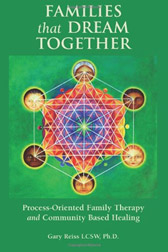 Families that Dream Together: Process-Oriented Family Therapy and Community Based Healing
Families that Dream Together: Process-Oriented Family Therapy and Community Based Healing
Gary Reiss
2013
With family life in such crisis, many political leaders say we should somehow go back and impose family values, but there is no going back. Nuclear families are no longer the majority in many Western cultures, and times have changed. Families that Dream Together offers a realistic method for our times that says with families challenged, blended, diverse, spread out across countries and the world, we need a method that helps families find the deeper myths and dreams, roots and wisdom of their connection. Utilizing the tools of Process-oriented Psychology, and indigenous and Shamanic based traditions, Dr. Gary Reiss offers solutions for today’s most pressing family problems. He shows how families are together trying to find answers for society’s biggest challenges through new methods of inner work and meditation, relationship work, communication, and community based healing.
This book will be helpful to professionals and anyone interested in understanding and working with family issues. Author Dr. Gary Reiss uses Process-Oriented Family Therapy to help families facing ongoing challenges of relationship in modern life. His work in community-based-healing reminds us of the importance and power communities can have in supporting family healing and development. – Dr. Arnold Mindell, founder Process Oriented Psychology.
Reiss, G. (2013). Families that Dream Together: Process-Oriented Family Therapy and Community Based Healing. Eugene, OR: Changing Worlds Publications.
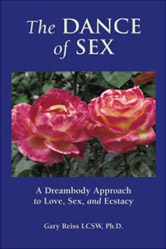 The Dance of Sex: A Dreambody Approach to Love, Sex and Intimacy
The Dance of Sex: A Dreambody Approach to Love, Sex and Intimacy
Gary Reiss
2013
In The Dance of Sex – A Dreambody Approach to Love, Sex, and Ecstasy, author Dr. Gary Reiss addresses the need for a new sexual revolution based on awareness, connection, ecstasy, and love, which integrates the best of sex therapy, relationship work, and spiritual approaches to sexuality including Tantra. Reiss’s approach offers simple non-threatening, powerful methods based on the Dreambody work of Process-oriented Psychology, which provides practical tools useful both at home and at the therapist’s office. Reiss’s methods have already helped hundreds of couples who had previously tried numerous other approaches to get their intimate and sex life flowing again.
His approach has enabled them to move beyond problems and into healing and ecstasy. This book is filled with stories, tools, and exercises to help us explore the richness of our sexual potential.
Gary Reiss supports professionals working with sexual issues, and individuals and relationship partners interested in bringing more ecstasy into their sex lives. The Dance of Sex is full of new and creative ways of enriching sexuality. Each chapter contains valuable exercises that make the book stimulating and exciting to read. – Arnold Mindell, founder Process Oriented Psychology.
Reiss, G. (2013). The Dance of Sex: A Dreambody Approach to Love, Sex and Intimacy. Eugene, OR: Changing Worlds Publications.
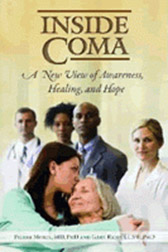 Inside Coma: A New View of Awareness, Healing, and Hope
Inside Coma: A New View of Awareness, Healing, and Hope
Pierre Morin & Gary Reiss
2010
A woman who is thought to have no consciousness is able to play tennis in her mind in a way that is measurable. Another person, who is given no chance of recovery, suddenly speaks after 20 years. People in comas fill hospital beds worldwide—and there is more reason for hope about their chances for recovery than ever.
Drs. Morin and Reiss share their unique experience of working with people in coma. Their book is exciting to read, full of valuable information and an important contribution to the growing field of process-oriented coma work. With their powerful mix of theory, client stories of remarkable journeys, and easy-to-follow exercises, the reader is taken into the world inside coma. It helps professionals and caregivers relate with people in coma, and with their own internal states. We highly recommend it. —Drs. Amy and Arnold Mindell, authors of Coma, A Healing Journey, and Coma, Key to Awakening.
Morin, P., PhD., M.D., & Reiss, G., Ph.D. (2010). Inside Coma: A New View of Awareness, Healing, and Hope. Santa Barbara: Praeger.
 Nothing Came From Walking: Surviving Encounters with the Spirit of Death
Nothing Came From Walking: Surviving Encounters with the Spirit of Death
Conor McKenna
2008
This book is a non-fictional account of a month-long inner and outer journey on the Maltese island of Gozo. Throughout this time, the writer was unknowingly suffering from cancer and it was only on the last day that the first signs of the illness emerged. The story moves through frightening and transforming inner and outer events during the month, culminating in the merging of inner dream-like figures and the outer physical manifestation of cancer. The battle between life and death is waged, but this book penetrates deeper, it is a fascinating account of going beyond the polarity of life and death. It is not just about illness, however, it is about hope; it s about the human spirit that can intervene with terrible dynamics within consciousness, and triumph.
Fabulous, fabulous, fabulous. I love your awareness, your matter-of-fact Zen-like stating of facts and the fun, dry humour that puts it all into perspective. AWESOME – Dr Max Schupbach
Conor has written an wondrous, awesome, almost poetic account mixing reality, dreaming and the dreambody nature of physical symptoms. – Dr. Arnold Mindell.
McKenna, C. (2008). Nothing Came From Walking: Surviving Encounters with the Spirit of Death. Duns, Scottish Borders: processworkfocus.com.
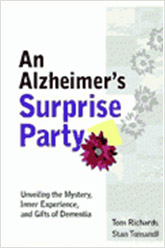 An Alzheimer’s Surprise Party: Unveiling the Mystery, Inner Experience, and Gifts of Dementia
An Alzheimer’s Surprise Party: Unveiling the Mystery, Inner Experience, and Gifts of Dementia
Stan Tomandl & Tom Richards
2009
Revolutionary and grounded in practical application, this book is filled with surprising research results that offer possibilities and comfort to millions of patients, families, and caregivers. The information and tools provided are both timely and essential, and could help transform the way people interpret and respond to patients with Alzheimers and other dementias.
NEW 2009 EDITION ALZHEIMER’S ASSOCIATION RECOMMENDED RESOURCE
An Alzheimer’s Surprise Party investigates the widely held belief that dementia is only a “mindless pathology”. Instead, the authors discover an essential, soulful, spiritual process that can be facilitated right from Alzheimer’s onset. This book provides pioneering and innovative research on the Alzheimer’s pandemic, and serves as an intimate, intense, compelling beacon, shining light on the disease’s potential for deeper meaning and spiritual healing.
I strongly recommend this as an original method of understanding and dealing with people in Alzheimer’s and other dementias. DR. ARNOLD MINDELL, PhD, founder of Process Oriented Psychology.
This book is revolutionary in providing hope and meaning for patients, relatives, friends, caregivers and professionals in the management of Alzheimer’s and other dementias. DR. ROSEMARY SHINKWIN, MD, MRCPsych.
Tomandl, S., & Richards, T. (2009). An Alzheimer’s Surprise Party: Unveiling the Mystery, Inner Experience, and Gifts of Dementia. Phoenix, OR: Interactive Media.
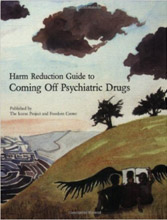 Harm Reduction Guide to Coming Off Psychiatric Drugs
Harm Reduction Guide to Coming Off Psychiatric Drugs
Will Hall
2007
This guide brings together the best information we’ve discovered and lessons we’ve learned at the Icarus Project and Freedom Center. It is not intended to persuade anyone to stop taking psychiatric medications, but instead aims to educate people about their options if they decide to explore going off.
In a culture polarized between the pro-medication propaganda of pharmaceutical companies on the one hand, and the anti-medication agenda of some activists on the other, we offer a harm reduction approach to help people make their own decisions. We also present ideas and information for people who decide to stay on or reduce their medications.
Many people do find psychiatric drugs helpful and choose to continue taking them: even with the risks, this may be a better option given someone’s situation and circumstances. At the same time, psychiatric drugs carry great dangers and can sometimes do terrible harm, even becoming bigger problems than the conditions they were prescribed to treat. Too often, people who need help getting off psychiatric drugs are left without guidance, and medication decisions can feel like finding your way through a labyrinth. We need honest information that widens the discussion, and we hope this guide helps people trust themselves more and take better care of one another.
Hall, W. (2007). Harm Reduction Guide to Coming Off Psychiatric Drugs. The Icarus Project & Freedom Center.
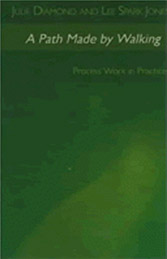 A Path Made by Walking: Process Work in Practice
A Path Made by Walking: Process Work in Practice
Julie Diamond & Lee Spark Jones
2005
Process work, a groundbreaking new form of psychotherapy, is explained and explored in this step-by-step guide for cutting-edge mental health professionals and individuals interested in self-therapy. Information on the history of process work, recent developments in the field, a discussion of background concepts and terms, and annotated client–facilitator case studies provide readers with a detailed framework for understanding the methodology, while tips and exercises on fundamental terms and concepts provide practitioners with the practical experience needed to administer the therapy. All aspects of the psychotherapeutic encounter are covered, including the structure of psychotherapeutic interactions and how to work within a therapeutic relationship.
Diamond, J., & Jones, L. S. (2005). A Path Made by Walking: Process Work in Practice. Portland, OR: Lao Tse Press.
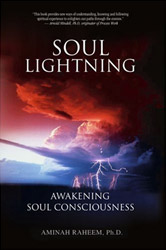 Soul Lightning: Awakening Soul Consciousness
Soul Lightning: Awakening Soul Consciousness
Aminah Raheem
2005
People the world over are awakening to soul consciousness – and that is what this book is about. Soul Lightning is the term the author uses to describe this awakening. Through individual stories and anecdotes, we are taken inside the images and feelings of the soul lightnings to confirm our oen awakenings. Aminah’s personal soul journey, and the life work that has evolved from it, bridge the gap between psychology and spirituality. In this book you will find models of your own life, lighting the way for a new way of being, woven from the stuff of your soul. This is essential information for anyone seeking inner wisdom and peace.
Soul Lightning corroborates the evolution of spiritual consciousness that is gathering critical mass to transform our planet. Amid the great challenges of our world, this is welcome news and a reminder of the importance of our individual awakening. As one reader expressed it, “This book is a healing and a blessing for everyone.”
Raheem, A. (2005). Soul Lightning: Awakening Soul Consciousness. Lincoln, NE: iUniverse, Inc.
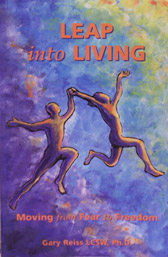 Leap Into Living: Moving From Fear To Freedom
Leap Into Living: Moving From Fear To Freedom
Gary Reiss
2004
In Leap Into Living-Moving Beyond Fear to Freedom, Psychotherapist Gary Reiss Ph.D., draws on his extensive knowledge of spiritual and psychological teachings to help us regain the essential freedom that is our human birthright.
Anxiety and fear are rampant in today’s world. Many of us live constricted lives, frightened to take a leap into the way we dream of living. Behind this widespread reluctance to take risks and live fully, we often find the fear of death. Great spiritual traditions have long known that becoming free to live our dreams requires addressing the intimately connected fears of living and dying.
Leap Into Livingbrings forth the essence of diverse spiritual traditions such as Taoism, Buddhism, and Judaism, as well as drawing extensively upon the author’s expertise in process-oriented psychology. In a clear storyteller’s style, Gary Reiss shows how people from all walks of life have used essential spiritual teachings to live and die more freely. He includes his own personal journey from anxiety to increased freedom, as well as case examples from his practice as a psychotherapist. Step-by-step exercises empower readers to lessen their fears of living and dying.
Reiss, G. (2004). Leap Into Living: Moving From Fear To Freedom. Eugene, OR: Changing Worlds Publications.
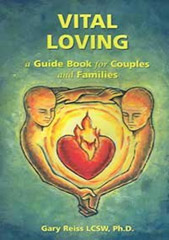 Vital Loving: A Guide Book for Couples And Families
Vital Loving: A Guide Book for Couples And Families
Gary Reiss
2004
In Vital Loving, psychotherapist Gary Reiss Ph.D., draws on his extensive knowledge of relationships and families o illuminate the loving potential inherent in all human relationships.
Vital Loving offers practical tools for dealing with the many challenges of modern relationship life, including separation and divorce, adolescent bahavior, stepfamily relationships, interpersonal violence, and grief and loss. Specific emphasis is given to making sexual life more exciting, intimate, and spiritual.
Vital Loving provides theory, tools and practicalexercises to help your relationships actualize their loving potential and reach their full vitality.
Reiss, G. (2004). Vital Loving: A Guide Book for Couples And Families. Eugene, OR: Changing Worlds Publications.
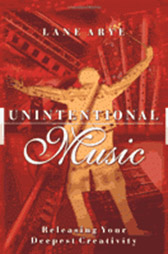 Unintentional Music: Releasing Your Deepest Creativity
Unintentional Music: Releasing Your Deepest Creativity
Lane Arye
2002
The last time you whistled a tune or hummed a song-why did you choose that one? You may not consider yourself a musical person, but your little act of unintended music may be the key to unlocking within you a wealth of unsuspected creativity-a kind of creativity that goes way beyond music, too. Lane Arye, PhD, a musician himself, focuses on the music that people do not intend to make. Using the highly regarded psychological model called Process Work, developed by Arnold Mindell, PhD, Arye has been teaching students around the world how to awaken their creativity, using music as the starting point, but including all art forms and ways of expression. The unintentional appears at moments when some hidden part of us, something beyond our usual awareness, suddenly tries to express itself. If we start paying attention to what is trying to happen rather than to what we think should happen, we open the door to self-discovery and creativity. Sometimes what we regard as “mistakes” in self-expression are in fact treasures. The book is rich with real-life stories, ideas, and practical techniques for unlocking creativity, which Arye dispenses with humor, insight, and enthusiasm.
An utterly new approach! This book has profoundly changed the way I play and teach music. Unintentional Music magically touches your soul at the same time it awakens your creativity. –Magdalena Schatzmann, Conservatory of Music in Bern, Switzerland.
This refreshingly original book is beautifully written, heartfelt, and soulful. With fun and excitement, it unveils a new world of music and creativity. The language itself reads like music. –Arnold Mindell, author of Dreaming While Awa.
Lane Arye, P. D. (2002). Unintentional Music: Releasing Your Deepest Creativity. Charlottesville, VA: Hampton Roads Publishing.
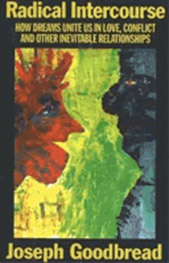 Radical Intercourse: How Dreams Unite us in Love, Conflict, and other Inevitable Relationships
Radical Intercourse: How Dreams Unite us in Love, Conflict, and other Inevitable Relationships
Joseph Goodbread
1997
Between the participants in any relationship, there exists a kind of enescapable communion whereby they create—dream up—parts of one another’s worlds of experience out of each other’s dreams. Rather than viewing this as a liability, it is a powerful learning too, offering practical strategies for making even the most difficult or unpleasant interaction a source of growth and new understanding.
Goodbread, J., Ph.D. (1997). Radical Intercourse : How Dreams Unite Us in Love, Conflict, and Other Inevitable Relationships. Portland, OR: Lao Tse Press.
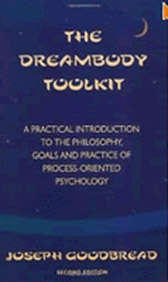 The Dreambody Toolkit: A Practical Introduction to the Philosophy, Goals, and Practice of Process-Oriented Psychology
The Dreambody Toolkit: A Practical Introduction to the Philosophy, Goals, and Practice of Process-Oriented Psychology
Joseph Goodbread
1987
This introduction to the theory and practice of process-oriented psychology explores this philosophy and places it in the context of other experientally-based therapies. An annotated transcript of an hour-long therapy session and a detailed exposition of the elementary methods of process-oriented psychology give this text a multifaceted view of this new theory.
The Dreambody Toolkit is a general introduction to the theory and practice of process oriented psychology. I tstarts with the basic philosophy of Process Work: that the client’s experience, no matter how disturbing, is meaningful and contains the seeds of its own resolution.
Goodbread, J., Ph.D. (1997). The Dreambody Toolkit: A Practical Introduction to the Philosophy, Goals, and Practice of Process-Oriented Psychology (2nd ed.). Portland, OR: Lao Tse Press.
*Inner work, relationship work, altered and extreme states of consciousness are intrinsically connected to worldwork. The following are books on Processwork theory and its various areas of application.
Books are available through:
Deep Democracy Exchange (DDX)
Process Work Institute (PWI)
